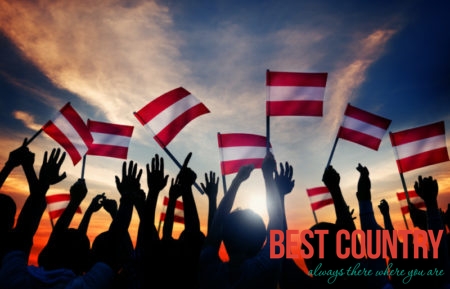Languages and population of Austria

German is the national official language and constitutes a lingua franca and de facto second language: most Austrians other than (mostly rural) seniors are able to speak it. It is the language used in media, in schools, and formal announcements.
The variety of German used, Austrian German is partially influenced by Austro-Bavarian and uses many "Germanized" words and expressions deriving from it.
High Alemannic German speaking areas marked in yellow, including part of the Austrian state of Vorarlberg (Switzerland).
Alemannic
Alemannic is spoken in Vorarlberg. Vorarlberg uses a High Alemannic, the same dialect group as that spoken in Northern Switzerland (outside Basel) and parts of southern Alsace, France.
It is fairly mutually intelligible with German; however, many Germans find it difficult to understand due to the phonological and grammatical differences.
Austro-Bavarian
The main native language of Austria outside Vorarlberg is Austro-Bavarian, which is spoken using many different dialects.
The northern parts of Austria (including Vienna, the capital) speak Central Austro-Bavarian dialects and the southern parts Southern Austro-Bavarian dialects. Austro-Bavarian is largely mutually intelligible with German, especially the Central dialects.
Minority languages
A number of minority languages are spoken in Austria, some of which have official status.
Turkish
Turkish is the largest minority language, in a situation mirroring that of Germany, spoken by some 2.3% of the population.
Serbian
Serbian is the second most spoken minority language, with usage by 2.2% of Austrians.
Burgenland Croatian
Burgenland Croatian, an official language in Burgenland, is spoken by 2.5% of Austrians, and Burgenland Croats are recognized as a minority and have enjoyed special rights following the Austrian State Treaty (Staatsvertrag) of 1955.
Hungarian-speaking areas in Europe, including a portion of the Austrian province of Burgenland.
Hungarian
While little spoken today, Hungarian has traditionally held an important position in Austria (or, more correctly, Austria-Hungary). Today, Hungarian is spoken by around 20,000 people (.05% of the Austrian population) in Burgenland.
Bosnian
The least spoken of Austria's minority languages, the Bosnian language is spoken by some .04% of the Austrian population.
Slovene
Slovene, an official language in Carinthia, is spoken by 0.3% of Austrians. Carinthian Slovenes are recognized as a minority and have enjoyed special rights following the Austrian State Treaty (Staatsvertrag) of 1955.
The latest population in Austria is 8,199,783. The gradual increase in the present rate is also a result of the opening of Eastern Europe that had great impact on the size and structure of the Austrian demography .
The population of the Austrian capital city at Vienna is around 1.6 million in the main city area. The total urban count when added with the population of the suburbs, comes to around 2.2 million, which is indeed alarming.
The total number of people residing alone in Vienna constitutes a major section of the population in Austria. The reason is that most immigrants from eastern and central parts of Europe preferred to settle in this beautiful city in Austria.
Compared to the Austrian capital, the total population strength in other parts of the country does not go beyond 1 million.
The second largest Austrian city, Graz houses 250,099 people, followed by Innsbruck with 117,346, Salzburg with 150,000 and Linz with 188,968 inhabitants. Rest of the Austrian cities comprises a population strength of less than 100,000 persons.
Population in Austria
Population in Austria is rising fearfully. To give it a proper check, the Austrian government should take sincere initiatives and efforts to stop population influx from other foreign lands that comprise a major part of the country's demography.